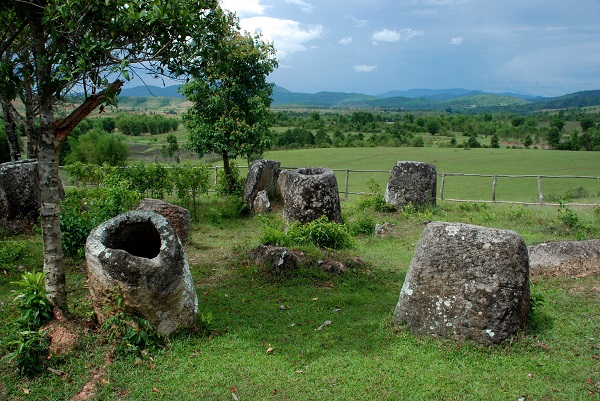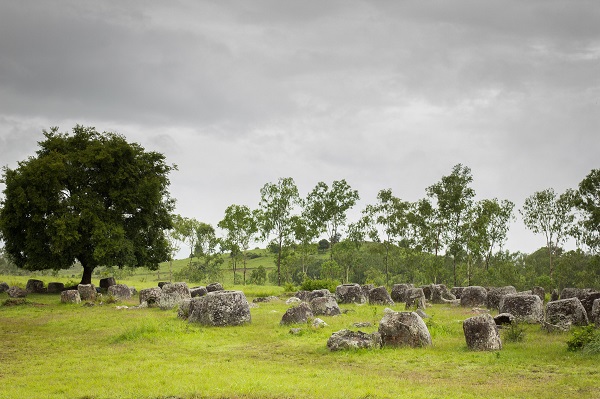This world is full of mysteries, about which we come to know from time to time and many such mysterious things still exist in this world, about which scientists have made unsuccessful attempts to unravel the secrets behind them. One such mystery lies in the South-Eastern Asian country of Laos, and this mysterious region is known as 'Plain of Jars'. The plain is a megalithic archaeological landscape consisting of thousands of mysterious stone jars that surprise the whole world and is considered one of the most important prehistoric sites in Southeast Asia. The origin of these mysterious stone jars is unknown, but archaeologists believe that they were originally used between 1,500 and 2,000 years ago.
See also:-The Mysterious Stone Spheres of Costa Rica
Image Source - Flickr
There are more than 90 jar sites found within Xiangkhouang Province of Laos, and each site has from one to 400 stone jars. The popular part of the plane of jars is 'Site 1', of the 90 known sites, which is the most famous, most touristy, and the busiest area, being closest to the city. There is a Cave located at Site 1, which is a natural limestone formation with an opening to the northwest and two man-made holes at the top. These holes are considered as chimneys for a crematorium. The stone structures are mostly made of sedimentary rock and, ranging from 1 to 3 meters in height and some stone jars have also been found attached to their lids (stone discs). Several rock types have been identified in the area such as sandstone, breccia, conglomerate, and limestone. But the majority of the jars are sandstone. The jars vary in diameter between 1 to 3 meters, and each can weigh up to 14 tons. Their shape is cylindrical with the bottom always wider than the top.
Also See:-Easter Island - The place of monumental statues
Image Source - Flickr
Despite being a UNESCO World Heritage Site, the area still remains one of the most dangerous archaeological sites in the world. Because the Plain of Jars was heavily bombed by the U.S. Air Force between 1964 and 1973, over 270 million cluster bombs were dropped on Laos during the Vietnam War and up to 80 million did not explode and remain a deadly threat to the population. In many sites of stone jars, these unexploded bombs still remain in the same way. However, from some sites, these bombs have been removed. Seven jar sites have been cleared of unexploded bombs and are open to visitors. These are currently sites 1, 2, 3, 16, 23, 25 and Site 52.
See Also:-Nazca Lines, Peru - A Shocking Feat Of Ancient Artwork
Image Source - Flickr
Archaeologists believe that these thousands of mysterious stone jars belong to the Iron Age but the mystery of why they were made at that time is still unclear. Some researchers believe that they may have been used as funerals urns or food storage. This mysterious and unique place now has the status of UNESCO World Heritage Site. The government of Laos had applied for it much earlier, after which it was inscribed in the World Heritage Sites on 6 July 2019.
See Also:-The Land of Giants, Iceland - Architects Turned Boring Electricity Pylons Into Majestic Human-Shaped Statues
Image Source - Flickr
See also:-The Mysterious Stone Spheres of Costa Rica
Image Source - Flickr
There are more than 90 jar sites found within Xiangkhouang Province of Laos, and each site has from one to 400 stone jars. The popular part of the plane of jars is 'Site 1', of the 90 known sites, which is the most famous, most touristy, and the busiest area, being closest to the city. There is a Cave located at Site 1, which is a natural limestone formation with an opening to the northwest and two man-made holes at the top. These holes are considered as chimneys for a crematorium. The stone structures are mostly made of sedimentary rock and, ranging from 1 to 3 meters in height and some stone jars have also been found attached to their lids (stone discs). Several rock types have been identified in the area such as sandstone, breccia, conglomerate, and limestone. But the majority of the jars are sandstone. The jars vary in diameter between 1 to 3 meters, and each can weigh up to 14 tons. Their shape is cylindrical with the bottom always wider than the top.
Also See:-Easter Island - The place of monumental statues
Image Source - Flickr
Despite being a UNESCO World Heritage Site, the area still remains one of the most dangerous archaeological sites in the world. Because the Plain of Jars was heavily bombed by the U.S. Air Force between 1964 and 1973, over 270 million cluster bombs were dropped on Laos during the Vietnam War and up to 80 million did not explode and remain a deadly threat to the population. In many sites of stone jars, these unexploded bombs still remain in the same way. However, from some sites, these bombs have been removed. Seven jar sites have been cleared of unexploded bombs and are open to visitors. These are currently sites 1, 2, 3, 16, 23, 25 and Site 52.
See Also:-Nazca Lines, Peru - A Shocking Feat Of Ancient Artwork
Image Source - Flickr
Archaeologists believe that these thousands of mysterious stone jars belong to the Iron Age but the mystery of why they were made at that time is still unclear. Some researchers believe that they may have been used as funerals urns or food storage. This mysterious and unique place now has the status of UNESCO World Heritage Site. The government of Laos had applied for it much earlier, after which it was inscribed in the World Heritage Sites on 6 July 2019.
See Also:-The Land of Giants, Iceland - Architects Turned Boring Electricity Pylons Into Majestic Human-Shaped Statues
Image Source - Flickr
















0 comments:
Post a Comment